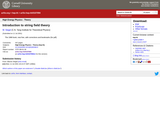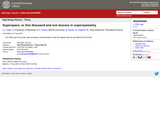
Introduction to String Field Theory
- Subject:
- Physical Science
- Physics
- Material Type:
- Textbook
- Provider:
- University of Maryland
- Author:
- Warren Siegel
- Date Added:
- 11/09/2017

Introduction to String Field Theory

We introduce superfields in chapter 2 for the simpler world of three spacetime dimensions, where superfields are very similar to ordinary fields. We skip the discussion of nonsuperspace topics (background fields, gravity, etc.) which are covered in following chapters, and concentrate on a pedagogical treatment of superspace. We return to four dimensions in chapter 3, where we describe how supersymmetry is represented on superfields, and discuss all general properties of free superfields (and their relation to ordinary fields). In chapter 4 we discuss simple (N = 1) superfields in classical global supersymmetry.
We include such topics as gauge-covariant derivatives, supersymmetric models, extended supersymmetry with unextended superfields, and superforms. In chapter 5 we
extend the discussion to local supersymmetry (supergravity), relying heavily on the compensator
approach. We discuss prepotentials and covariant derivatives, the construction of actions, and show how to go from superspace to component results. The quantum aspects of global theories is the topic of chapter 6, which includes a discussion of the background field formalism, supersymmetric regularization, anomalies, and many examples of supergraph calculations. In chapter 7 we make the corresponding analysis of quantum supergravity, including many of the novel features of the quantization procedure (various types of ghosts). Chapter 8 describes supersymmetry breaking, explicit and spontaneous, including the superHiggs mechanism and the use of nonlinear realizations.
We have not discussed component supersymmetry and supergravity, realistic superGUT models with or without supergravity, and some of the geometrical aspects of classical supergravity. For the first topic the reader may consult many of the excellent reviews and lecture notes. The second is one of the current areas of active research. It is our belief that superspace methods eventually will provide a framework for streamlining the phenomenology, once we have better control of our tools. The third topic is attracting increased attention, but there are still many issues to be settled; there again, superspace methods should prove useful.
We assume the reader has a knowledge of standard quantum field theory (sufficient to do Feynman graph calculations in QCD). We have tried to make this book as pedagogical and encyclopedic as possible, but have omitted some straightforward algebraic details which are left to the reader as (necessary!) exercises.